
Organizing and hosting a symposium is one of the biggest challenges for law review editors. Working with faculty, visiting scholars, and authors from near and far can be quite a task to manage - especially if you’ve never done it before! To learn more about how law reviews successfully pull together a symposium, we interviewed editors at two law reviews who are currently preparing for their upcoming symposia. In this post, Buffalo Law Review’s Ari Goldberg, Executive Editor, and Kerry Battenfeld, Editor-in-Chief, share how they are putting together their symposium.
Why did your board decide to host a symposium on the particular topic you chose?
Buffalo Law Review (BLR): Every year, the University at Buffalo Law School hosts a lecture series organized by a professor in this school. This year, the lecture is on the editing of the genetic code with Clustered Regularly Interspaced Short Palindromic Repeats (CRISPR) technology and the effect of CRISPR on law and society. The professor hosting the lecture, Irus Braverman, had interest in publishing the articles submitted to the lecture with Buffalo Law Review, and we, too, had interest in publishing the articles.
Overall, we decided to publish this collection of articles because, after careful deliberation, Buffalo Law Review decided the opportunity could not be missed. Professor Braverman assembled an impressive, diverse group of scholars to spark a thorough discussion of CRISPR and gene drive. For example, Kevin Esvelt, a pioneering researcher on gene drive and CRISPR technology will be part of the lecture. To be a facilitator of that discussion by publishing those scholars is an incredible opportunity.
How did your board start planning the symposium? Are you getting any help from faculty or practitioners in the field as you organize the symposium?
BLR: We met with Professor Braverman several times. We crafted guidelines in terms of article length, duty and authority of Professor Braverman and Buffalo Law Review, and most important to us, we created a citation cheat sheet, which contained a brief outline of the Bluebook with plenty of examples of basic citations that the authors might use. We also had some concern over these scholars using language unfamiliar to our members and subscribers. Through our conversation with Professor Braverman, we ensured the authors would make good faith efforts to write plainly without losing any complexity of the ideas in their writings.
What are you doing to promote your symposium to potential attendees and readers?
BLR: All Buffalo Law Review members will be aware of the date of the lecture series, which, fortunately, is at our law school. All Executive Publication Editors must attend, and hopefully, they will meet the authors of the articles they edit. We are also making sure other interested students are aware of the lecture series, and we are using the school’s own marketing. The lecture series will also be available online. We will encourage all Buffalo Law Review members to attend.
Based on your experience, what has been the most difficult part of organizing a symposium? How have you dealt with that?
BLR: The most difficult thing is balancing our purpose as a law review with publishing some articles grounded in more scientific knowledge, and ensuring the members of the law review are not overwhelmed with editing articles on topics many of them are not familiar with. We have been dealing with that by encouraging attendance at the lecture. Then, the editing will not be the first time these law review members immerse themselves in these ideas. We also engaged our current members prior to even deciding to publish. This way, all potential issues and concerns were discussed prior to publishing–nothing about this symposium will be a surprise.
What has been the most rewarding part of organizing your symposium?
BLR: The most rewarding part is to know Buffalo Law Review will assist in catalyzing an important conversation on gene editing and the societal and legal effect of such a groundbreaking technology. Also, to challenge ourselves as legal scholars; to get out of our comfort zones a little and review articles that are not facially legal, yet present ideas that will likely come up in our lives as future attorneys.
Do you have any advice for a law review that is planning on organizing their first symposium, or that is looking to improve the way they currently organize their symposium?
BLR: The first thing is to seriously consider the benefits and risks of symposium publication. A symposium can often be the go-to-source for a single topic, but it may also come with editing headaches many law reviews should avoid. We opened the discussion up to the articles review team and the Executive Publication Editors for their respective opinions. With their approval, we decided to publish. Their concerns were also conveyed to Professor Braverman and laid the foundation for shaping the relationship between the Professor, authors, and law review.
Second, law reviews need to do a lot of groundwork prior to even receiving the articles. Especially, with articles written by non-legal scholars, preparing outlines of bluebook citations, setting guidelines for article length, communicating a general way of how to write for law reviews and how law reviews edit, and having as many law review members as possible attend the lecture, are all effective ways to mitigate potential risks of publishing a symposium. More initial groundwork will save time and headaches later.
Lastly, the professor that organizes or edits the symposium needs to, as Professor Braverman has done wonderfully, advocate for his or her authors and empathize with the law review doing the editing work. What worked for us, was often and honest communication. This ensured that members were not overwhelmed, surprised, or unprepared for the challenge in front of them.
To read more about on how another law review organizes their annual symposium, check out the next post (out Friday, July 29) in this 2-part series!







